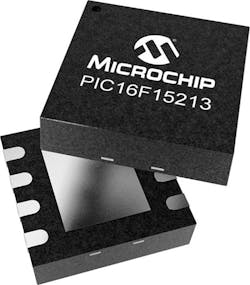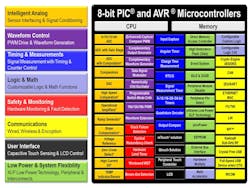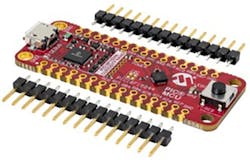IoT Control Using 8-Bit MCUs
What you’ll learn:
- 8-bit MCUs continue to thrive via continued innovations in several areas including memory, power consumption, packaging, and core-independent peripherals (CIPs).
- New generations of MCUs incorporate an increasing amount of memory, if necessary, to facilitate the growing need for code space.
- Today’s 8-bit MCUs aren’t limited to just data collection. They collect, process, and transfer data in numerous IoT applications.
Dating back to the 1970s, microcontrollers (MCUs) have played a prominent role in controlling a variety of automotive, consumer, and industrial products. Today, this role has expanded to include portable, wireless, and wearable Internet of Things (IoT) products. Alongside IoT, healthcare also has seen massive growth and an adoption of 8-bit MCUs into a variety of applications.
Embedded electronics with 8-bit MCUs require devices that can compete in economies of scale (hundreds of thousands to sometimes millions of units per application). For example, in automotive applications, 8-bit MCUs control many subsystems such as motorized seats and windows to smart door handles and even tire pressure sensors. This means that a price difference of a few cents is quite important.
Another aspect of the application cost, often overlooked in the design phase, is the maintenance cost of millions of devices. Reliability and device durability can be improved through code simplification and hardware instead of requiring software redundancies.
Among the reasons that 8-bit MCUs continue to thrive and compete over the years is their ability to provide value to the user. This has been achieved by continued innovations in several areas but especially memory, power consumption, packaging, and core-independent peripherals (CIPs).
Dramatic 8-Bit Improvements
As today’s focus on IoT has grown and entire cities are being upgraded with smart devices, the ability to implement intelligence at scale has become critical for many industries. These upgrades include smart streetlights and parking garage detectors at each parking location—not just a single counter at the entrance.
Certain features are required of microcontrollers to create an environment capable of IoT. These can be boiled down to three capabilities: the ability to gather data, process that data, and then communicate the data to other networked devices.
In many cases, the collection, processing, and transferring of data can be completed by an 8-bit MCU with an on-chip analog-to-digital converter (ADC), while the core of the device remains in a low-power mode. For example, the sensors/indicators in a smart parking garage, connected street lighting, automated urban gardening, and plant monitoring are all candidates for this approach. Every milliwatt of power multiplied by the thousands can really stack up when a system operates night and day.
Not only are the benefits and value of smaller devices seen in their reduced power consumption, but also their smaller form factor. This enables them to fit into limited space in portable, battery-powered IoT products.
The newest generation of microcontrollers are being developed with that sense of value in mind. Using new processes, allowing for more memory at low costs, these microcontrollers have the user’s wallet in mind while providing the functionality required for the application.
Memory
The microcontrollers of a few years ago are much different than the devices currently on the market. Those devices were revolutionary for their time and changed the landscape of embedded circuitry. Due to the leaps and bounds made in the development of flash memory, modern programs have grown to fill the available space.
With the trend toward more complex applications, new programs require more space/memory. Consequently, new generations of MCUs include an increasing amount of memory, if necessary, to facilitate the growing need for code space.
Embedded flash memory can last years, as required and demonstrated by strenuous automotive testing, enduring numerous write and erase cycles. These capabilities add another dimension to the value proposition of 8-bit microcontrollers. Today, the amount of memory in an 8-bit microcontroller can range from as little as 384 bits to as much as 128 kB and even more to satisfy an increasing number of applications.
Power Consumption
Since many 8-bit MCUs are used in battery-powered applications, among the significant changes that has occurred is the quest for the lowest power consumption.
For example, nanoWatt XLP eXtreme Low Power PIC MCUs include system supervisory circuits specially designed for battery-powered products. Thus, these microcontrollers can offer the industry’s lowest currents for Run and Sleep, where extreme low-power applications spend 90%-99% of their time. Circuitry, such as Peripheral Module Disable, completely removes peripherals from the power rail and clock tree for zero power leakage. Benefits of nanoWatt XLP Technology include:
- Sleep currents below 20 nA
- Brown-out reset down to 45 nA
- Watchdog timer down to 220 nA
- Real-time clock/calendar down to 470 nA
- Run currents down to 50 μA/MHz
- Full analog and self-write capability down to 1.8 V
These low currents help increase battery life for portable applications. Additional power savings are possible through optimized peripherals that will be discussed later.
Packaging
Another major difference for 8-bit vs. 16-bit or 32-bit MCUs is the small packages that enable 8-pin devices to fit into the smallest spaces in space-conscious wireless/portable and wearable products. Examples include an 8-pin SOIC and 8-pin DFN. A popular package is the 20-pin very thin quad flat pack no-leads (VQFN) with its 3- × 3-mm footprint (Fig. 1). While adding more features may necessitate more connections and larger packaging, 8-bit MCUs with sufficient capability can fit into board spaces that prohibit the use of 16- or 32-bit MCUs.
If an 8-bit microcontroller’s increased capability requires larger area and more connections due to the increased system complexity it provides, larger packages, including 40-pin PDIP and VQFN and 44-pin TQFP versions, are used as well.
Core-Independent Peripherals
Separating certain aspects of the microcontroller from the central core provides autonomy from the core and several benefits, especially for low-power/low-cost designs. These core-independent peripherals have increased functionality built-in for reduced power usage and modular design. This helps simplify the implementation of touch interfaces, sensor data accumulation, and conditioning, as well as facilitating complex software implementation into hardware and more.
CIPs are designed with additional capabilities to handle a variety of tasks without the need for intervention from the microcontroller’s central processing unit (CPU). This design approach provides a pre-packaged means of programming events based on peripherals. For example, the Event System can trigger events based on general-purpose input/output (GPIO) or program interrupt on multiple channels
Currently available CIPs for 8-bit PIC and AVR microcontrollers in Figure 2 are shown in color-code by peripheral category. The eight categories and their subcategories address most of the functionality expected in a cost-effective, embedded controller. Note the green items provide additional power-reduction possibilities to those mentioned earlier.
CIPs offer increased reliability by reducing the amount of code overhead. Functions implemented with hardware structures avoid potential software conflicts. In addition, peripheral interconnectivity in hardware reduces external connections, boosting the end system’s reliability. The increased reliability of components decreases cost over the lifetime of the project.
Many of the new 8-bit families provide a plethora of options in memory and pin counts. These make it possible to complete development on larger devices and scale down production to the smaller devices when the actual code size is optimized.
For example, in a variety of packages for cost-sensitive sensor and real-time control applications, the PIC16F152XX microcontroller family’s simplified feature set includes a 10-bit ADC, peripheral pin select (PPS), digital communication peripherals, and timers. Memory features include the memory access partition (MAP) to support users in data protection and bootloader applications.
Design Tools to Accelerate and Simplify Design-in
With advances to the development tools, many processes that had to be hard-coded can be simplified and generated through the appropriate design tools, such as the MPLAB Code Configurator (MCC). This has several benefits, namely the reduction of time needed to develop an application. Moreover, code can be implemented that’s more compact than a designer might have been able to develop without several iterations of code or writing the code from scratch in assembly. For example, the PIC16F15244 Curiosity Nano Evaluation Kit with full programming and debugging capabilities offers complete support for a new design (Fig. 3).
The free MPLAB X Integrated Development Environment (IDE) provides a development environment to create code for 8-bit (and 16- and 32-bit) MCUs to simulate, interface with hardware tools, and access Microchip as well as third-party plug-ins.
A Bright (and Cost-Effective) Future
Microcontrollers have come a long way and 8-bit MCUs continue to demonstrate tremendous resilience and application innovations through advances in memory, power consumption, packaging, and peripherals. They not only have larger memory that may be required for complex applications, but also many different avenues for simplifying complex applications. This simplification can be realized in reduced money/time spent developing the project as well as lower costs when the MCU goes into production.
Today’s 8-bit MCUs aren’t limited to just data collection. They collect, process, and transfer data in numerous IoT applications. New 8-bit products have responded to the growing complexity of applications with greatly increased memory sizes and optimized peripherals.
However, small format and cost-sensitive designs, including sensor and simple real-time control applications, can benefit from simplified feature sets like that of the 8-bit PIC16F152xx family. With their core-independent peripherals, such MCUs provide an obvious choice for most designers.
About the Author
Joshua Bowen
Product Marketing Engineer, 8-bit MCU business unit, Microchip Technology
Joshua Bowen is a Product Marketing Engineer for the 8-bit MCU business unit at Microchip Technology. He received his Bachelor of Science degree in Engineering from Arizona State University.



